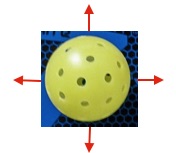PB Myth # 18: You Should Never Miss Your Serve
**NOTE** – This is an article from Third Shot Sports that is reprinted with appropriate attribution and permissions.
The conventional wisdom is that you should always make sure your serve lands in. We don’t want you to hit out either but here is something to consider: if you are always playing it safe for fear of missing, are you losing out on a great opportunity?
Yes. You are.
Think about it — the serve is the one time in a pickleball game that you have complete control. The ball is in perfect position, you are totally on balance and you don’t have to hit it until you are completely ready. There is no other moment when the conditions are so much in your favour. Yet most people squander this opportunity by merely putting the ball in play. Here are some alternatives:
1) Aim for a weakness. If you have identified that your opponent has a preferred side (usually their forehand) this is a great time to challenge them to play the shot they don’t want. Use this opportunity to aim near a sideline and force them to hit a tougher return.
2) Pin them back. In most cases, the returner will want to come to the net after playing the ball. Make this more difficult by serving deep in the court and pushing them back behind the baseline.
3) Take away their time. A slow, high-arcing ball gives your opponents lots of time to prepare for the return. Why not hit the serve with some speed and challenge them to catch up?
4) Hit with spin. Add some difficulty by using sidespin or topspin on the serve. Doing so will make the ball bounce differently than the usual spin-free shot.
With each of these suggestions I’m encouraging you to “go for more” when hitting your serve. And yes, there is some risk in doing so. Hitting near the sideline increases the chance that the ball will go wide. Aiming for the back of the court or trying to hit the serve fast may mean your ball occasionally sails long. Hitting with spin will likely reduce your control and cause you to miss.
But with these risks comes the possibility of real reward.
A more challenging serve makes it more likely that your opponent will fail to hit the return the way they want. They are more likely to struggle with their first shot which is good news for you. They are more likely to hit the return short. They are less likely to have pinpoint accuracy. They are more likely to hit out of bounds.
Of course, if you are hitting many of your serves out of play, you are probably being too aggressive. And one ought to be selective about when they choose to go for more (serving at 9-10-2 might not be the ideal time to attempt an un-returnable serve). But I don’t see anything inherently wrong with the occasional missed serve so long as it is the result of looking to gain an advantage with the first shot.
There is an old saying that “if you aren’t falling, you aren’t trying hard enough”. Perhaps we could adapt this to “if you never miss your serve, you aren’t going for enough”.
Mark Renneson is a pickleball coach and 5.0/PRO level competitor. He is the founder of Third Shot Sports. He can be reached by email mark@thirdshotsports.com.
In Summary, I think these are the take-aways from the article:
- Conventional wisdom is often “safe,” but may not be the best for a given play.
- Serving is the only time a player has total control of the situation.
- Serve to an opponent’s weakness. (You have to find it first)
- Still serve the ball deep.
- Change the style of serve using spin, pace, etc.
- Weigh the risk-rewards ratio for your style of play and decide if you should “go for it” at certain times. (As the article points out, in a close game I tend to play it conservatively most of the time and just get the ball in the service box.)
Click the link to register to receive the Third Shot Sports Pickleball Newsletter
Click the link to see Third Shot Pickleball Past Newsletters.
Click the link to visit the Third Shot Sports Pickleball website.
Thanks to Mark and Third Shot Sports for allowing this to be presented on JBRish.com
Link to the Original Article- http://www.thirdshotsports.com/articles/2016/9/9/pb-myth-18-you-should-never-miss-your-serve
The comments at the bottom of the article are interesting with people sharing their personal philosophies and ideas.
